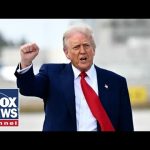President Trump has once again demonstrated his willingness to take bold action in the global trade arena, announcing a 125% tariff on all Chinese goods—a move that has sent shockwaves through markets and international diplomacy. This aggressive escalation is aimed at addressing long-standing grievances over China’s trade practices, including intellectual property theft, currency manipulation, and state-sponsored subsidies. While critics decry the move as reckless, supporters argue it is a necessary step to protect American industries and workers from unfair competition.
The steel industry, among others, stands to benefit significantly from this policy shift. For years, American manufacturers have struggled to compete against cheap imports from China, which dominates global steel exports. By imposing these tariffs, Trump aims to level the playing field for domestic producers, reinvigorating industries that have been hollowed out by decades of globalization. The tariffs not only protect American jobs but also send a clear message that the United States will no longer tolerate economic exploitation disguised as free trade.
China’s response has been swift and predictable, raising its own tariffs on U.S. goods to 125% in retaliation. Beijing has criticized the move as “unilateral intimidation,” but Trump’s administration remains unfazed. Treasury Secretary Scott Bessent expressed optimism about the potential for new trade agreements with other nations eager to capitalize on America’s pivot away from China. Countries like Argentina, Vietnam, and Israel have already signaled their willingness to negotiate favorable deals, underscoring the strategic advantage of Trump’s hardline approach.
While the stock market has experienced turbulence amid these developments, Trump’s supporters argue that short-term volatility is a small price to pay for long-term economic sovereignty. The president’s unapologetic stance reflects his broader philosophy: America first. By prioritizing domestic industries and workers over globalist agendas, Trump is reshaping the rules of international trade in favor of fairness and reciprocity. Critics may scoff at his methods, but the results speak for themselves—American companies are beginning to see growth opportunities that were previously stifled by foreign competition.
Ultimately, this tariff policy marks a turning point in U.S.-China relations and signals a broader shift in America’s economic strategy. Trump’s willingness to confront China head-on demonstrates his commitment to defending American interests in an increasingly competitive global landscape. As negotiations unfold and new alliances emerge, one thing is certain: under Trump’s leadership, the United States will no longer be a passive player in the game of global trade but an assertive force demanding respect and accountability.




